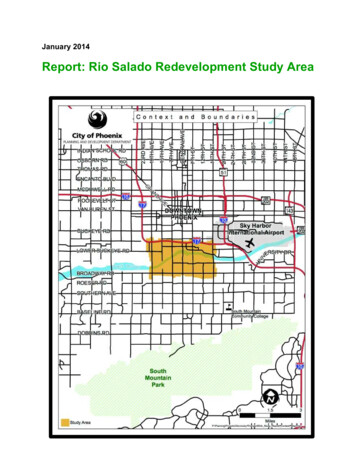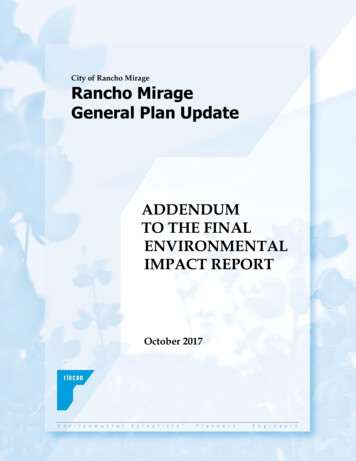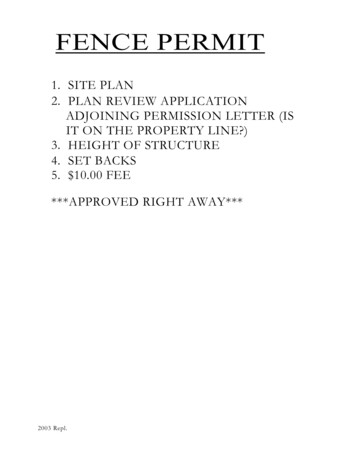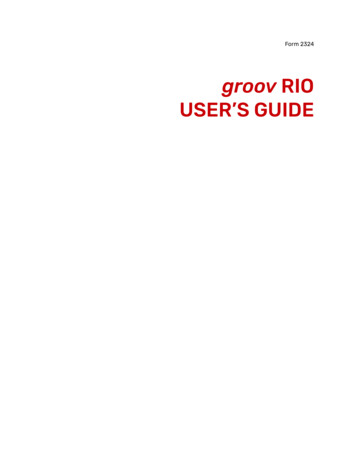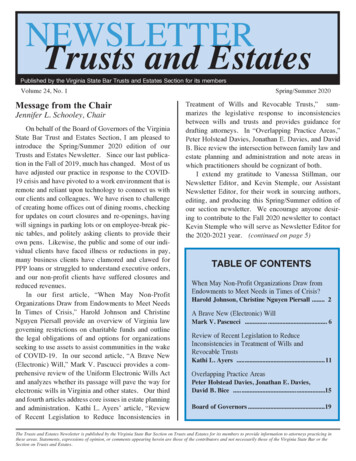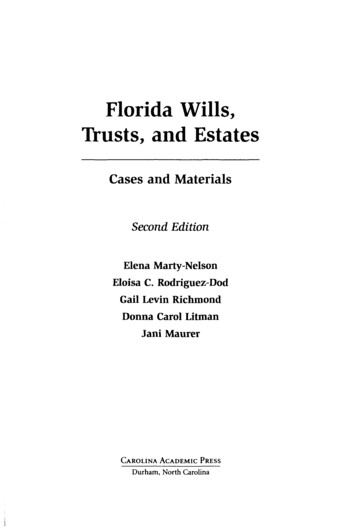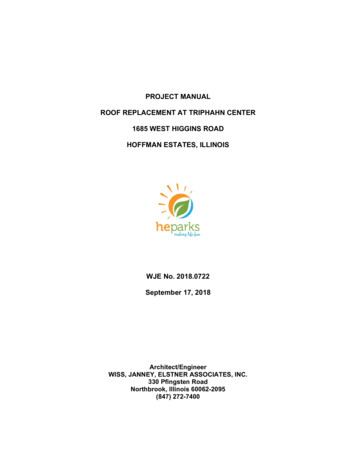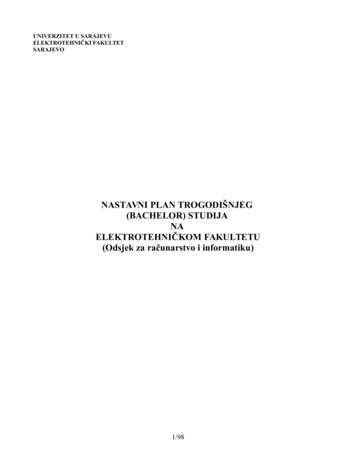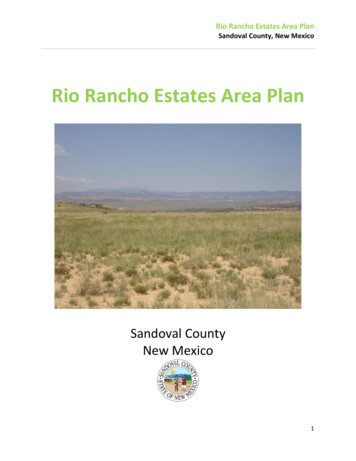
Transcription
Rio Rancho Estates Area PlanSandoval County, New MexicoRio Rancho Estates Area PlanSandoval CountyNew Mexico1
Rio Rancho Estates Area PlanSandoval County, New MexicoBoard of County CommissionersDarryl Madalena, County CommissionerDistrict 5, Chair.Orlando Lucero, County CommissionerDistrict 1, Vice-ChairNora Scherzinger, County CommissionerDistrict 2Don Chapman, County CommissionerDistrict 3Glenn Walters, County CommissionerDistrict 4Phil Rios, County ManagerPatrick Trujillo, County AttorneyPlanning and Zoning CommissionJohn Arango, ChairPat Vester, Vice-ChairLarry McClaine, MemberRobert Cote, MemberJames Maduena, MemberSam Landee-Thompson, MemberPlanning and Zoning Division StaffMichael Springfield, Division DirectorBrad Stebleton, Senior PlannerMakita Hill, Long Range Senior Planner (Project Manager)John Lorne, Zoning OfficerJeff Epler, GIS ManagerGary Pals, GIS AnalystEdward Montoya, Right of Way SpecialistKelly Romero, Support CoordinatorMaria Encinias, Administrative AssistantLesley Picchione, Administrative Assistant2
Rio Rancho Estates Area PlanSandoval County, New MexicoRio Rancho Estates Area PlanAcknowledgementsSection 1: Purpose of the Plan .5Section 2: History and Local/Regional Context 6Section 3: Existing Water Supply Conditions . 8Section 4: Antiquated Land Platting and Land Ownership .11Section 5: Zoning and Land Use . . 13Section 6: Population .15Section 7: Infrastructure and Public Safety .17Section 8: Natural Environment and Cultural Resources .20Section 9: County Planning Initiatives/Interagency Planning . 24Section 10: Land Planning . . . 26Section 11: “Do Nothing” Scenarios .36Section 12: Plan Concept .37Section 13: Development Policy . .42Section 14: Implementation Measures . 443
Rio Rancho Estates Area PlanSandoval County, New MexicoAcknowledgementsMuch knowledge and expertise has been contributed to the Rio Rancho Estates Area Plan(RREAP) through inter-agency collaboration with the County. The Southern Sandoval CountyArroyo Flood Control Authority (SSCAFCA) has contributed land development standardsregarding on-site rainwater detention, which is critical to controlling development-relatedwater drainage into arroyos and reducing flood potential. The Ciudad Soil and WaterConservation District and the USDA Natural Resources Conservation Service have contributedenvironmentally low-impact land development guidelines consistent with the erosiveconditions of the soils in the plan area. The NM Environment Department has also contributedknowledge on the functioning of independent water and liquid waste infrastructure districts.The NM State Land Office, NM Department of Game and Fish, as well as the City of Rio Ranchoand the Rio Rancho Public Schools, have also been active participants in the development ofland use policy for the Rio Rancho Estates Area Plan.4
Rio Rancho Estates Area PlanSandoval County, New MexicoSECTION 1Purpose of the PlanIntroductionThe Rio Rancho Estates Area Plan (RREAP) is designed to establish policy on the following issuesfor the plan area:1. Neighborhood Preservation.2. Minimum Development and Habitation Standards for Existing and Future NeighborhoodAreas.3. Identification of Areas of New Non-Residential Development.4. Potential for Large-Scale Public Redevelopment.5. Open Space Preservation for Water and Environmental Conservation.In 2001, Sandoval County adopted its current Comprehensive Plan. In that plan, the Rio RanchoEstates area was identified as one of six “planning regions” in Sandoval County and the planstated that the County in the future would develop more detailed land use plans for eachregion that would reflect the “ unique characteristics, constraints, and growth pressures of(each) region ” These plans are to be consistent with the general policies in the County’sComprehensive Plan. The Board of County Commissioners in 1987 adopted such a plan for theAlgodones area, in 2007 for the Jemez Valley, and in 2009 for the Placitas area.The RREAP reflects the unique characteristics, the constraints, and the growth pressures in thisspecific area. The land use and management goals, strategies, and recommendations set forthin this area plan will guide the decision process for future development, and futurepreservation, in the plan area. The RREAP area is illustrated in Figure 1.Intergovernmental CooperationSandoval County is the lead governmental agency for the RREAP and is responsible for thecontent of this plan. The County will facilitate a planning process in cooperation with the Cityof Rio Rancho, the Town of Bernalillo, the Pueblo of Zia, the Pueblo of Laguna, the SouthernSandoval County Arroyo Flood Control Authority (SSCAFCA), Ciudad Soil and WaterConservation District, the New Mexico State Land Office/Bureau of Land Management (BLM),the New Mexico State Engineer’s Office, the New Mexico Environment Department (NMED),the New Mexico Department of Transportation (NMDOT), the Mid-Region Council ofGovernments (MRCOG), and private land owners. Woven into these efforts is a commitment tofacilitate positive change in the RREAP area through appropriate land planning, and arecognition of the great possibilities and potential this area holds for all residents of SandovalCounty and the State of New Mexico.5
Rio Rancho Estates Area PlanSandoval County, New MexicoSECTION 2History and Local/Regional ContextFigure 1, RREAP Area. Source: Sandoval County Planning and Zoning/GIS Division.The area of south central Sandoval County, now known as Rio Rancho Estates, is made up of aportion of the Town of Alameda Land Grant, dating from Spanish settlement in the 1700’s, aswell as a portion of the King Ranch. During the years from 1960 to 1975, the American Realtyand Petroleum Corporation (AMREP) purchased 90,000 acres of this land and subdivided it intothousands of lots, mostly one-half and one acre parcels. Through an extensive advertisingcampaign, many of these properties were sold to individuals from all over the world. By 1977,AMREP had sold 75,000 of these lots. The 1980 census recorded approximately 10,000residents in the southeastern portion of the original AMREP land holdings. Rio Ranchoemerged in this process as an urban area, and in 1981, incorporated. Through successiveannexations, Rio Rancho became one of the fastest growing cities in the United States and nowholds more than 85,000 residents, including just over half of the original AMREP land holdings.The last annexation by the city in this area was in 2006 when two-1 square mile portions ofState-owned land north of Paseo del Volcan and east of Unser Boulevard were added to the6
Rio Rancho Estates Area PlanSandoval County, New Mexicocity. The remaining unincorporated area of roughly 60 square miles, and 43,629 acres (knownherein as the “plan area”) located west of the city limits is the RREAP project area.Figure 2, AMREP Land Sales Promotion in the 1960’s. Source: AMREP.Within the plan area, the State of New Mexico holds two truncated sections of land(approximately 1,100 acres), with additional State owned parcels surrounding the plan area toeast, north, and south. Much of the remainder is divided into thousands of parcels as part ofthe original AMREP subdivisions. Approximately one-third of the lots are owned by AMREPCorporation, while the rest are held by thousands of individuals all over the world, some theheirs of now deceased purchasers of the land in the 1960’s and 70’s (Figure 2). The area grewslowly through most of its history, mainly due to a lack of infrastructure and the distance toemployment and services. In 2000, the County’s Planning & Zoning Division tallied 395dwellings in this area, just over three-quarters of them mobile or manufactured homes. In2010, Sandoval County estimates that there are 514 dwellings in this area. Assuming anaverage of 2.5 persons per dwelling unit, there is an estimated population of 1,285 people inthe plan area, more than in the Sandoval County municipalities of Cuba, San Ysidro, or JemezSprings.7
Rio Rancho Estates Area PlanSandoval County, New MexicoSECTION 3Existing Water Supply ConditionsTo understand the Estates and its potential as a County community, it is important to establishan understanding of existing water supply conditions in the area as a point of departure. TheCounty has contracted with an environmental engineering firm to assess the amount ofunderground aquifer water needed to support full residential build-out of the Estates area, andthe amount of underground water currently available. Preliminary findings indicate thatapproximately 16,000-acre feet of water annually would be needed to support a full residentialbuild-out scenario on the 40,000 lots in the Estates, and that only 8,000-acre feet of waterannually is available underground on a renewable basis (APPENDIX). The 8,000-acre feet ofwater in the Estates is also a source of water supply for the City of Rio Rancho.The City’s current water allotment under permits from the New Mexico Office of the StateEngineer is approximately 24,000 acre feet of water annually. To date, the City has secured halfof this supply. With a population of just over 85,000, Rio Rancho’s incorporated area is only 1/3built, leaving most of the city area vacant. The remaining 12,000 acre-feet to be acquired bythe City will provide for a maximum build out of ½ of the incorporated area. The Estates areacomprises a portion of the water “well field” for City use, and is also the water supply forCounty residents. Typical depths for private water wells in the Estates ranges in depth from900 to 1,150 feet. The average cost of drilling and installing a private water well in the Estatesunder current circumstances is approximately 30,000.00 (APPENDIX). Current Rio RanchoEstates Community District (CD-RRE) zoning regulations allow up to three connections for eachwell licensed by the New Mexico Office of the State Engineer. A new well is permitted to pumpa maximum of 1-acre feet of water annually.Currently, there are 63 individual private wells and 30 private shared wells in the Estates area,providing well water to approximately 120 housing units. The City of Rio Rancho has extendedwater utility lines into the Estates area on Northern Boulevard from Rainbow Boulevard toEncino Road, and from Northern Boulevard to King Boulevard. Along Northern Boulevardwestward to Encino Road, there are currently 255 housing units connected to this water line.The total number of housing units receiving water from either a water well or a water line isapproximately 375. The City of Rio Rancho also currently operates a water supply station onNorthern Boulevard near Encino Road, where County residents may purchase and haul water(Figure 3). Approximately 139 housing units depend on this station and other privately ownedwater hauling services in the Estates area.In the event of development of a new major residential subdivision in the area, the newsubdivision would be subject to the Sandoval County Subdivision Regulations, Appendix A,which requires that a 100-year assured water supply for all new lots must be demonstrated,and that the water study must include the potential for impacts/impairments on existing waterrights holders in the area, including the City of Rio Rancho.8
Rio Rancho Estates Area PlanSandoval County, New MexicoGiven the water availability in the Estates, a full residential build out of the Estates is notpossible. Under this scenario, water availability to both County and City residents would bejeopardized. Add to this scenario the presence of over 40,000 septic systems operating in thearea, the quality of the water would be jeopardized as well. The accessibility to water byEstates residents, the availability of water in the Estates for County and city residents, andwater quality, will serve as the foundation upon which the RREAP will be built and maintained.In order to better understand how the plan will accomplish this task, it is important tounderstand the circumstances and history surrounding the land in the Estates, and how thesecircumstances can lend to a process of planning for the Estates that will balance these needs.9
Rio Rancho Estates Area PlanSandoval County, New MexicoFigure 3, Water Lines and Distribution Center. Source: Sandoval County Planning and Zoning Division/GIS.10
Rio Rancho Estates Area PlanSandoval County, New MexicoSECTION 4Antiquated Land Platting and Land OwnershipThe original Rio Rancho Estates platting process created thousands of lots through a series oflarge subdivisions that were approved and recorded in the Office of the Sandoval County Clerkin the 1960’s and early 1970’s. According to Sandoval County parcel data, there areapproximately 48,000 parcels of land which are generally one-half or one acre in size in the planarea. All of these lots were of record prior to 1973 when New Mexico adopted its firstSubdivision Act for Counties, and prior to establishment of County zoning. The controls andsafeguards traditionally associated with subdivision regulation, such as terrain managementand adequate infrastructure, were not implemented in the plan area, resulting in an antiquatedsubdivision.Antiquated subdivisions have occurred throughout New Mexico and in many parts of theUnited States. Common circumstances created by these subdivisions include a lack of plannedinfrastructure improvements (paved roads, water, sewer, gas) as well as inadequate streetlayouts and a lack of collector and arterial street planning necessary to provide ease of ingressand egress for the subdivision. Rio Rancho Estates carries these conditions, as well as a landpattern that does not conform to the area’s natural features which include 100-year arroyoflood areas. Many parcels have been platted within or immediately abutting arroyo floodareas, and with the flood hazard and erosive qualities of these areas, these parcels cannot befeasibly developed. The City of Rio Rancho and Sandoval County now share jurisdiction oversubdivisions in much of the plan area, however, the potential impact of current subdivisionregulations in this antiquated area is limited.Land ownership in the plan area is very diverse and presents a great challenge to developing acoordinated land use plan in the plan area. AMREP, the original land subdivider, ownsapproximately one-third of the parcels in the plan area, making it the largest single land owner(Figure 4). The next largest land owner in the plan area is the State Land Office, which ownsapproximately 1100 acres within the plan area and another two and one half 1-mile sections ofland bordering the plan area, together totaling nearly 2900 acres. There are many other privateland owners in the plan area who own large numbers of parcels as well. It is estimated by theSandoval County Assessor’s Office that approximately 30,000 parcels of land in the plan areaare owned by individuals in other states throughout the United States and the world.From a water availability standpoint, the number of existing parcels in the Estates cannot beserved with a water source. Also, changes in the tools of redevelopment of antiquated areashave occurred that bring new challenges for large area planning.11
Rio Rancho Estates Area PlanSandoval County, New MexicoFigure 4. Rio Rancho Estates Platting and Ownership. Source: Sandoval County Planning and Zoning/GIS Division.12
Rio Rancho Estates Area PlanSandoval County, New MexicoSECTION 5Zoning and Land UseThere was no zoning in the plan area until 1990, when Sandoval County amended itsComprehensive Zoning Ordinance to cover the unincorporated areas of the County outside ofAlgodones. As with most of the County, the plan area was “blanketed” by the DR(Development Review) District. The DR District allowed residential uses, including mobilehomes, and agricultural uses by right. Any change to non-residential and non-agricultural usesrequired a conditional use permit or a zone change. Zone change and conditional use activity inthe area, reviewed by the County’s Board of County Commissioners and Planning & ZoningCommission, was very limited under the DR classification, mainly confined to requests for nonresidential land uses. DR zoning did not require building setbacks, nor did it provide anystandards for mobile homes or manufactured housing. Sandoval County revised the DR zone in2001, establishing elements of the Algodones district standards for County-wide use in thecreation of the Rural Residential Agricultural (RRA) zone district. The RRA district allows singlefamily residences including mobile homes, agricultural uses and the raising of animals, publicparks and open space, utility structures, and related uses.By 2001, the plan area contained a wide variety of housing units, including some very old anddilapidated single-wide mobile homes, many of which were not set on permanent foundationsand thus were not subject to taxation as real property. Many of these properties alsodeveloped illegal shared well systems which created sanitation-related health problems. In thatyear, and in response to the problem of largely unregulated development and related healthissues, Sandoval County adopted a 6-month moratorium prohibiting permits for single-widemobile homes and homes connected to shared well systems with more than five connections.Illegal dumping has been a serious problem in this area as well.During the interim period, the County’s Planning & Zoning Division, Planning & ZoningCommission, and Board of County Commissioners developed a new zoning District for the areaknown as the Rio Rancho Estates Community District (CD-RRE), which requires permanentfoundations for mobile homes and a standard for shared residential wells to not exceed threeresidences. The RRE district was developed in public meetings with property owners andrepresentatives of the manufactured housing industry. The Ordinance creating the District wasadopted by the Board of County Commissioners on November 1, 2001. With the exception of apair of large public utility facilities, the plan area is entirely within the CD-RRE Zone District.Land use in the plan area continues to be primarily single family residential (Figure 6).13
Rio Rancho Estates Area PlanSandoval County, New MexicoFigure 5, County RRE Zoning/Land Use. Source: Sandoval County Planning and Zoning/GIS Division.14
Rio Rancho Estates Area PlanSandoval County, New MexicoSECTION 6PopulationPopulationFrom 2000 to 2010, the number of dwelling units in the RREAP area grew from an estimated395 to 514. Assuming an average of 2.5 persons per dwelling unit, there is an estimatedpopulation of 1,285 people in the plan area, which, over the 10-year period, is a growth rateexceeding 50%. Further population growth in the plan area at this rate underscores the needfor a plan for the plan area.The City of Rio Rancho is the third largest municipality in New Mexico, and one of the fastestgrowing urban areas in the United States. From 2000 to 2010, Rio Rancho grew from apopulation of 51,756 to an estimated population of over 85,000, a 60% increase over this 10year period. Draft population projections generated by the Mid-Region Council ofGovernments (MRCOG, Figure 7) indicate that by the year 2035, Rio Rancho may grow to apopulation exceeding 210,000. Rio Rancho Planning Department staff expects a moremoderate growth rate, anticipating a maximum population of 135,000 within this timeframe.This population will be accommodated within the current Rio Rancho city limits, and the cityhas no plans for annexation of land within the plan area in this time frame.15
Rio Rancho Estates Area PlanSandoval County, New MexicoFigure 6, Population and Employment Growth 2008 - 2035. Source: Mid Region Council of Governments.16
Rio Rancho Estates Area PlanSandoval County, New MexicoSECTION 7Infrastructure and Public SafetyLiquid WasteAt present, there are no sanitary sewer lines extending outside of the city limits. Clusters ofsewage treatment lines are currently in place in Rio Rancho at Southern Boulevard and Paseodel Volcan west of the City Center/Campus Center, adjacent to the plan area. Residents in theplan area use onsite liquid waste systems for sewage disposal, most of them septic systems.The New Mexico Environment Department (NMED) has jurisdiction over liquid waste systems inthe plan area. As the existing ½-acre lots were platted prior to adoption of the ¾-acre minimumlot size for a standard septic system, the NMED was previously obligated to approveapplications for septic systems for these lots. In these areas where standard septic systems arein closer proximity to wells, well water is subject to exposure to bacteria and nitrates, whichmay also spread among greater numbers of residents through the use of multiple connectionson existing wells. Today, the NMED licenses individual alternative active treatment systems inthe area which are much safer for water users and for the environment.Solid WasteSandoval County does not require its residents to have solid waste collection at their homes.Residents have the option of contracting for the service from a private company or taking theirtrash to the Sandoval County landfill, located on Idalia Road near Paseo del Volcan and withinclose proximity to the plan area. The unpaved roads in the area can cause difficulties for trashpickup, particularly during periods of inclement weather. There have been a number ofincidents where residents have stored and buried large quantities of trash and garbage on theirproperty or where trash has been dumped illegally. Sandoval County has sponsored a numberof “cleanup days” over the past several years and continues to enact enforcement measures forillegal dumping in the area.Other Utility InfrastructureThe plan area is within the electric service area of the Public Service Company of New Mexico(PNM), and the gas service area of the New Mexico Gas Company (NMGS). PNM and NMGSservices extend into the plan area. There is a NMGS gas service line along Southern Boulevardwhich extends west of Rainbow Boulevard to Hondo Road, and there are gas transmission linesin operation along Encino Road and Idalia Road. PNM operates an east-west transmission linein the plan area between Prospect Boulevard and King Boulevard, and a north-southtransmission line along 60th Street. These transmission lines meet at the PNM switching stationat the Prospect Boulevard, Encino Road intersection. Electric service lines are also in the planarea, extending westward from Rainbow Boulevard along King Boulevard and NorthernBoulevard to Encino Road and along Southern Boulevard to 60 th Street. North-south electriclines extend along Encino Road between King Boulevard and the Sandoval County line, andalong 60th Street from Southern Boulevard to Alice King Way. Electric lines extend along AliceKing Way westward from 60th Street into the Rio Puerco area.17
Rio Rancho Estates Area PlanSandoval County, New MexicoTransportationThose portions of the study area that are already subdivided are crisscrossed by a network ofmostly unpaved roads, 657 miles in total, that are maintained by Sandoval County. Theseroads were created by AMREP in its original subdivisions. The layout of these roads is generallyformed along a mile grid network with rectangular block structure in the southern portion ofthe plan area (Figure 8). This grid network bears no relation to existing topography, except inthe northern part of the plan area where the grid pattern is irregular due to the extensivearroyos in the Calabacillas watershed. Major access into the plan area includes major streetsNorthern Boulevard and Southern Boulevard, which serve as the major East/West roadways,with Northern paved west near 30th Street, and Southern paved west near 40th Street.Paseo del Volcan, a planned new limited access highway, is under construction and will traversethe plan area in an east-west and north-south configuration, ultimately connecting NMHighway 550 with Interstate 40. To date, Paseo del Volcan has been constructed from US 550to Unser Boulevard. The Mid Region Council of Governments Metropolitan Transportation Plan(MTP) 2035 establishes further construction plans for Paseo del Volcan during this time period.Between current time and 2035, Paseo del Volcan will be built as a 2-lane road betweenSouthern Boulevard and Unser Boulevard, then the road will be widened from 2 lanes to 4 lanesfrom Unser Boulevard to Iris Road and from Iris Road to US 550. In the process, new majorPaseo del Volcan road intersections will be created at Northern and Southern Boulevards withinthe plan area. This road project will bring opportunities for new development and economicactivity that will benefit County and Rio Rancho residents.King Way Boulevard, a future east-west roadway, will serve as a major corridor from the RioPuerco to the central portion of the plan area and Rio Rancho. In addition, 40th Street and 60thStreet will function as secondary north-south major roadways providing access within the planarea, and to the Rio West Master Plan area and the Rio Puerco region. These five roadwaystherefore constitute the backbone of the network. At present there is no public transportationwithin the plan area. Opportunities may exist for such service in the future as the areadevelops.Public SafetyCurrently there are no fire stations or fire protection/EMS facilities located within the area. TheCity of Rio Rancho addresses most incidents in the area, with assistance from more distantSandoval County Fire Districts. The lack of water service in the area has also resulted in a lack offire hydrants and other fire protection facilities in the area, leaving many residents vulnerablein the event of a fire. The few hydrants in the plan area are part of the Rio Rancho watersystem and connect to their transmission lines. Police protection is provided to the study areaby the Sandoval County Sheriff’s Department. The Department has no facilities in the area, thenearest one being located several miles away in the Town of Bernalillo. The relatively lowpopulation and lack of diverse development in the area has limited the amount of crime.18
Rio Rancho Estates Area PlanSandoval County, New MexicoFigure 7, RREAP Transportation Map. Source: Sandoval County Planning and Zoning/GIS Division.19
Rio Rancho Estates Area PlanSandoval County, New MexicoSECTION 8Natural Environment and Cultural ResourcesNatural Vegetation and SoilsThe natural vegetation in the plan area is dominated by native grasses and shrubs (Figure 9).The elevation ranges from about 5,500 feet in the east side to about 6,200 feet at the west. Atelevations above 5,800 feet are scattered native woodland trees. The soil in the plan area iscomprised of five variations of sandy loam. These soils are subject to erosion when the naturalvegetation is disturbed by off road vehicle use, maintenance of roads, and the humandisturbance around existing developed areas. Due to the impacts of development in the areaand off road vehicle use, the erosion of top soil is a major issue and contributes to air pollutionfrom dust exposed to prevailing southwesterly winds. Loss of vegetation and subsequent topsoil erosion are among the existing environmental problems associated with human activity inthe plan area.Figure 8, Natural Vegetation. Source: USDA National Resources Conservation Service.20
Rio Rancho Estates Area PlanSandoval County, New MexicoTerrain and DrainageThe plan area is relatively flat with small rolling hills and an average grade of less than 5%, andis generally more level than the city of Rio Rancho which contains areas with slopes as steep as12%. However, the plan area shares development constraints with the city due to the similarityin its network of watershed arroyos and floodplains (Figure 10).There is an extensive network of open escarpment spaces adjacent to the Rio West area, RioPuerco area, and the State Land Office/BLM land and Zia Pueblo to the north. The majorfloodway/arroyo network in the RRE is comprised of the Panta de Leon, Montoya, andCalabacillas arroyo watersheds. The Calabacillas watershed is the second largest drainage wayin the middle Rio Grande region after the Tijeras Arroyo . The upper watershed in SandovalCounty falls within the jurisdiction of the Southern Sandoval County Arroyo Flood ControlAuthority (SSCAFCA). Currently, almost the entire 100 year floodway area in the plan area isunder the jurisdiction of SSCAFCA, and is also under private ownership.In 2006, southern areas in Rio Rancho and Sandoval County suffered a 100-year flood eventthat damaged several neighborhoods, roads, and bridges due to the lack of proper drainageinfrastructure and planning, causing an estimated 2.6 million dollars in damage. Drainageconcerns in the plan area to date have been limited due to the fact that most of the area isvacant. However, the original AMREP platting was on a “grid” layout with little recognition ofthe rolling terrain and heavy summer downpours in the area. As development increases in thisarea, drainage issues will become increasingly important. While the drainage and floodwaynetworks of the plan area are a major natural feature, planning for the area must consider notonly the preservation of the natural features within the 100 year flood zone, but also planningfor adequate storm water facilities to support new development.The Panta de Leon, Montoya, and Calabacillas arroyo networks are included in the SSCAFCAQuality of Life Master Plan for Watershed Park. The Plan identifies the Panta de Leon andMontoya arroyo networks for trail and open space connectivity in the area, with the Panta deLeo
Rio Rancho Estates Area Plan Sandoval County, New Mexico 5 SECTION 1 Purpose of the Plan Introduction The Rio Rancho Estates Area Plan (RREAP) is designed to establish policy on the following issues for the plan area: 1. Neighborhood Preservation. 2. Minimum Development and Habitation Standards for Existing and Future Neighborhood Areas. 3.
